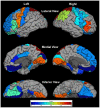Regional brain differences in cortical thickness, surface area and subcortical volume in individuals with Williams syndrome
- PMID: 22355403
- PMCID: PMC3280212
- DOI: 10.1371/journal.pone.0031913
Regional brain differences in cortical thickness, surface area and subcortical volume in individuals with Williams syndrome
Erratum in
- PLoS One. 2012;7(5): doi/10.1371/annotation/e4ec835e-932f-4956-b9fd-7113eee67347
Abstract
Williams syndrome (WS) is a rare genetic neurodevelopmental disorder characterized by increased non-social anxiety, sensitivity to sounds and hypersociability. Previous studies have reported contradictory findings with regard to regional brain variation in WS, relying on only one type of morphological measure (usually volume) in each study. The present study aims to contribute to this body of literature and perhaps elucidate some of these discrepancies by examining concurrent measures of cortical thickness, surface area and subcortical volume between WS subjects and typically-developing (TD) controls. High resolution MRI scans were obtained on 31 WS subjects and 50 typically developing control subjects. We derived quantitative regional estimates of cortical thickness, cortical surface area, and subcortical volume using FreeSurfer software. We evaluated between-group ROI differences while controlling for total intracranial volume. In post-hoc exploratory analyses within the WS group, we tested for correlations between regional brain variation and Beck Anxiety Inventory scores. Consistent with our hypothesis, we detected complex patterns of between-group cortical variation, which included lower surface area in combination with greater thickness in the following cortical regions: post central gyrus, cuneus, lateral orbitofrontal cortex and lingual gyrus. Additional cortical regions showed between-group differences in one (but not both) morphological measures. Subcortical volume was lower in the basal ganglia and the hippocampus in WS versus TD controls. Exploratory correlations revealed that anxiety scores were negatively correlated with gray matter surface area in insula, OFC, rostral middle frontal, superior temporal and lingual gyrus. Our results were consistent with previous reports showing structural alterations in regions supporting the socio-affective and visuospatial impairments in WS. However, we also were able to effectively capture novel and complex patterns of cortical differences using both surface area and thickness. In addition, correlation results implicate specific brain regions in levels of anxiety in WS, consistent with previous reports investigating general anxiety disorders in the general population.
Conflict of interest statement
Figures



References
-
- Dykens EM. Anxiety, fears, and phobias in persons with Williams syndrome. Dev Neuropsychol. 2003;23:291–316. - PubMed
-
- Morris CA. The behavioral phenotype of Williams syndrome: A recognizable pattern of neurodevelopment. Am J Med Genet C Semin Med Genet. 2010;154C:427–431. - PubMed
-
- Dykens EM, Rosner BA, Ly T, Sagun J. Music and anxiety in Williams syndrome: a harmonious or discordant relationship? Am J Ment Retard. 2005;110:346–358. - PubMed
-
- Mobbs D, Eckert MA, Mills D, Korenberg J, Bellugi U, et al. Frontostriatal dysfunction during response inhibition in Williams syndrome. Biol Psychiatry. 2007;62:256–261. - PubMed
Publication types
MeSH terms
Grants and funding
LinkOut - more resources
Full Text Sources

